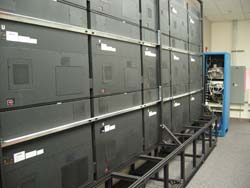Feeling Secure

- Surveillance and security applications are facing a major surge in AV spending at all levels of government, driven not only by an increased concern for security but also by steadily expanding bandwidth availability and capabilities in AV systems for these tasks. Estimates of the true size of the government AV market, at all levels, are hard to come by. For one thing, a significant piece of this pie is hidden-in Defense, Homeland Security, and other applications that don't publish their activities. Secondly, AV spending is spread so widely, through so many agencies and levels of government, that an accurate appraisal of the market is impossible.
The Mesa, AZ Traffic Management Center (TMC) is an example of how advanced traffic management centers are using display walls and display wall controllers for a range of capabilities, including security.
InfoComm's 2005 AV Trends and Opportunities Study: State and Local Government estimated that state and local governments spend some $1.2 billion on AV annually, an expenditure projected to grow by 12 percent each of the next several years. Moreover, the managers of the Government Video Expo held annually in Washington, DC describe the federal video marketplace as a $9.4 billion piece of business. It has been estimated that governments, at all levels, probably make up the largest customer group in the AV industry. Increasingly, what these avid customers are buying is video, and a growing portion of that video investment is being devoted to surveillance and security.
There is a difference between surveillance and security, of course.
Surveillance gathers information and delivers it to decision makers in a timely and useful manner; but all by itself, it does not control access to facilities or prevent unapproved activities. As a result, meeting the security needs of government requires a blend of security and AV expertise.
The effort is being facilitated recently by the blossoming of bandwidth availability for moving video and other data around in organizations.
Comprehensive, high-quality video surveillance is more practical today than ever before. Digital video cameras are inexpensive and capable enough to be deployed in large numbers, and they can be linked to command centers either through dedicated networks-often relying on fiber optics or other highly secure connections-or over the internet. Users can not only monitor the images collected by these cameras but control them remotely, pursuing the specific information required at a given time.

Jupiter display wall controllers have recently been integrated into powerful command and control systems in every setting from airports and traffic management centers to the front lines of combat.
At Madrid Barajas International Airport in Spain, for instance, a new system provides surveillance along with the ability to monitor what airlines, flights, and crews are using particular gates. The airport's baggage handling operations are monitored by a separate surveillance system. An even larger installation at Munich's international airport allows the facility to monitor passengers, baggage and airport personnel.
The growing availability of very high-quality video also supports the rollout of such new technologies as facial recognition and other "biometric security" tools. Advanced Traffic Management Centers (TMCs) are adding important new dimensions to the familiar uses of "traffic cams" to monitor road congestion. New TMCs allow local and state governments to pull enormous amounts of information into a centralized location and display it to support good decisions. In addition to allowing officials to respond quickly to traffic conditions, these systems provide surveillance, security, and enhanced communication among services and localities in an emergency.
A daily selection of the top stories for AV integrators, resellers and consultants. Sign up below.
